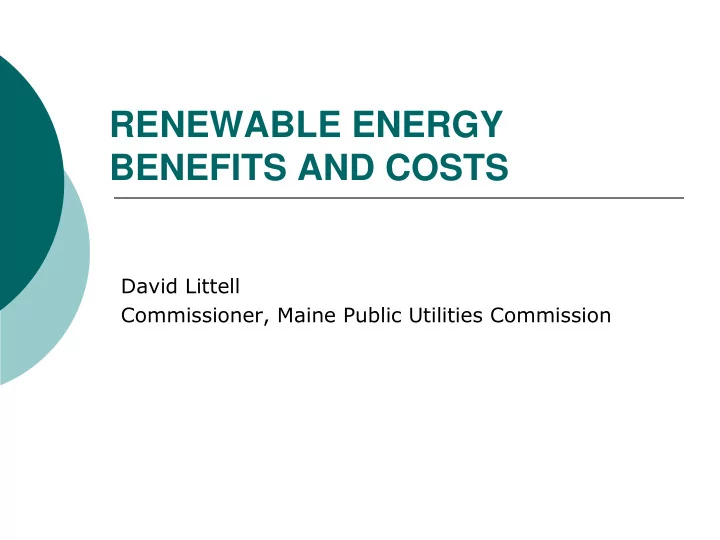

RENEWABLE ENERGY BENEFITS AND COSTS David Littell Commissioner, Maine Public Utilities Commission
Renewables Economic benefits for ratepayers & state Higher upfront (capital) costs Environmental benefits & impacts Reliability, diversity, hedge benefits
Data Source: US Energy Information Agency (EIA), Average Price by State by Provider (EIA-861), http://www.eia.gov/electricity/data/state/avgprice_annual.xls
Data Source: US Energy Information Agency (EIA), Average Price by State by Provider (EIA-861), http://www.eia.gov/electricity/data/state/avgprice_annual.xls
Maine Retail Electricity Prices Are the Lowest in New England State Commercial Industrial All Sectors /kWh* /kWh* /kWh* ME 12.70 ¢ 8.14 ¢ 12.49 ¢ NH 14.37 ¢ 11.63 ¢ 14.70 ¢ VT 14.74 ¢ 9.95 ¢ 14.42 ¢ MA 13.70 ¢ 11.63 ¢ 14.70 ¢ CT 15.18 ¢ 12.45 ¢ 16.79 ¢ RI 13.26 ¢ 11.96 ¢ 14.36 ¢ NY 15.28 ¢ 6.21 ¢ 15.36 ¢ NJ 12.20 ¢ 10.24 ¢ 13.25 ¢ PA 9.53 ¢ 6.97 ¢ 9.93 ¢ * Data Source: EIA, “Electric Power Monthly with data for November 2014” (Release Date: January 2015), Table 5.6.A. Average Retail Price of Electricity to Ultimate Customers by End-Use Sector,by State. http://www.eia.gov/electricity/monthly/
Maine Standard Offer Retail Electricity Prices Maine Standard Offer (Default Service) Retail Supply Rates Are Also Competitive Utility Small Medium Large CMP 6.544 ¢/kWh 7.640 ¢/kWh 8.401 ¢/kWh EM-BHD 6.504 ¢/kWh 7.723 ¢/kWh 8.137 ¢/kWh EM-MPD 8.493 ¢/kWh 8.493 ¢/kWh 11.120 ¢/kWh Data Source: Maine Public Utilities Commission, Standard Offer Rates. March 2015. http://www.maine.gov/mpuc/electricity/standard_offer_rates/index.html
Small Class Standard Offer Prices Flat to Declining ¢/kWh 2008 2009 2010 2011 2012 2013 2014 2015 CMP 9.974 8.924 9.029 8.491 7.438 6.826 7.560 6.544 EM-BHD 10.05 8.996 8.782 8.252 7.139 6.695 7.576 6.504 EM-MPD 8.539 8.333 8.625 7.300 7.300 7.300 8.493 8.493 Note: Price reported for the Year is for the majority of months of that Year Data Source: Maine Public Utilities Commission, Standard Offer Rates. http://www.maine.gov/mpuc/electricity/standard_offer_rates/index.html
Renewable Development = Economic Benefits Direct Marginal energy prices New capacity Price suppression Indirect Economic Development Moderation of Fuel Supply Risk Longer term price stability Hedging benefit
Renewables Direct Economic Impact Renewables like wind, hydro, solar and tidal need to run when the resource is present These are “price taking” resources in electricity market Price takers displace more expensive generators in each hour available. This often lowers prices in hours renewables are available An example of this appears in the recent summary of the GE NEWIS study performed for ISO-NE GE estimates that at 20% wind generation in ISO-NE market there’s an average $5 -11/MWh annual price decrease $650 million to $1.4 billion average annual energy price decrease in New England region* *Based on $5-11/MWH for 130,370 GWh, see ISO-NE, Net Energy & Peak Load Report (Nov 2010) (Sep ’09 - Oct ’10 NEL); see also GE New England Wind Integration Study Summary (Nov. 16, 2010).
Subsidy Imbalance Masks Portion of Economic Benefit of Renewables EIA Study* Indicates Fossil Fuels received 48% of 2007 subsidies per unit of electricity production Nuclear Received 19% Renewables Only Received 15% At comparable levels of subsidy the hourly price impact of resources like wind would be even greater than the estimated $650-$1,400 million decrease. *Energy Information Administration Office of Coal, Nuclear, Electric, and Alternate Fuels “Federal Financial Interventions and Subsidies in Energy Markets 2007,” Table 34 Pg. 105 (April 2008)
Globally, Government Subsidies Distort Price Signals *Source: IEA, World Energy Outlook 2010
Indirect Economic Impacts Local employment in construction and maintenance Potential manufacturing, research, For small-scale systems more sellers, installers, and servicers Lease revenues to landowners Increased Local Property Tax Revenues
East Coast Sea Level Rise
Carbon Pollution Reduction Risk to the world from global warming is well known, and potentially catastrophic. Sea levels “began to rise in the 19th century, around the same time that advanced countries began to burn large amounts of coal and oil” “The sea has risen about eight inches since then, on average” Scientists project a rise of 3 feet in the US with “...an estimated 5,000 square miles of dry land and 15,000 square miles of wetlands...at risk of permanent inundation” * Renewable energy helps push trends like ocean acidific, sea level rise, and climate change resulting from CO2 intensive energy production in the opposite direction. * “As Glaciers Melt, Science Seeks Data on Rising Seas,” Justin Gillis, New York Times (Nov. 13, 2010).
NOx emissions fall 26% (6,000 tons) 60,000,000.00 SOx emissions fall 6% (4,000 tons) CO2 emissions fall 25% (12 million tons) 50,000,000.00 70000 40,000,000.00 60000 50000 30,000,000.00 2008 New England 40000 Emissions 20,000,000.00 Estimated Emissions at 30000 20% Wind 20000 10,000,000.00 10000 - 0 CO2 NOx SO2 Wind resource growth to 20% of generation yields a better than 20% decrease in CO2 and NOx, and a sizable decrease in SOx. * * See GE NEWIS study summary for ISO-NE
Coal Extraction Mountaintop Removal, Mine cave-ins, explosions, long burning mine fires (e.g. Centralia, PA), contaminated run-off
Oil and Natural Gas Extraction Spills, Contaminated waste water, Sludge, extensive infrastructure: including roads, jet-landing strips and pipelines, Hydrofracking risk to ground water
Nuclear Extraction Destructive mining similar to coal, radioactive uranium tailings from mining, waste from fuel processing, and risk of nuclear weapons proliferation
Renewables and Transmission Should Meet Strong Siting Standards • Consider impacts of transmission • Permit carefully, limit environmental impacts – Visual, audio, bird/bat, habitat impact risks – Biomass can use waste and sustainable forest harvest – Consider multiple time and scale dimensions in analysis
Recommend
More recommend